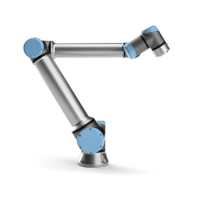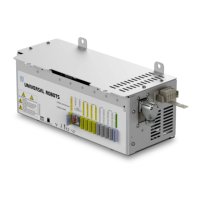15.1 Changing the Safety Configuration
ments of the robot arm, and of safety function settings for the configurable inputs and
outputs. They are defined in the following subtabs of the safety screen:
• The General Limits subtab defines the maximum force, power, speed and mo-
mentum of the robot arm. When the risk of hitting a human or colliding with a
part of its environment is particularly high, these settings need to be set to low
values. If the risk is low, higher general limits enable the robot to move faster and
exert more force on its environment. For further details, see 15.9.
• The Joint Limits subtab consists of joint speed and joint position limits. The
joint speed limits define the maximum angular velocity of individual joints and
serve to further limit the speed of the robot arm. The joint position limits define
the allowed position range of individual joints (in joint space). For further details,
see 15.10.
• The Boundaries subtab defines safety planes (in Cartesian space) and a tool ori-
entation boundary for the robot TCP. The safety planes can be configured either
as hard limits for the position of the robot TCP, or triggers for activating the Re-
duced mode safety limits (see 15.5)). The tool orientation boundary puts a hard
limit on the orientation of the robot TCP. For further details, see 15.11.
• The Safety I/O subtab defines safety functions for configurable inputs and
outputs (see 12.2). For example, Emergency Stop can be configured as an input.
For further details, see 15.12.
15.1 Changing the Safety Configuration
NOTE:
The recommended procedure for changing the safety configuration
is as follows:
1. Make a risk assessment.
2. Adjust safety settings to the appropriate level (refer to relevant
directives and standards from our manual on how to set the
safety limits).
3. Test the setting on the robot.
4. Put the following text in the operators’ manuals: “Before work-
ing near the robot, make sure that the safety configuration is as
expected. This can be verified e.g. by inspecting the checksum in
the top right corner of the PolyScope (see 15.4 in the PolyScope
Manual).”
CB3 II-94 Version 3.1 (rev. 17782)
Copyright © 2009-2015 by Universal Robots A/S. All rights reserved.

